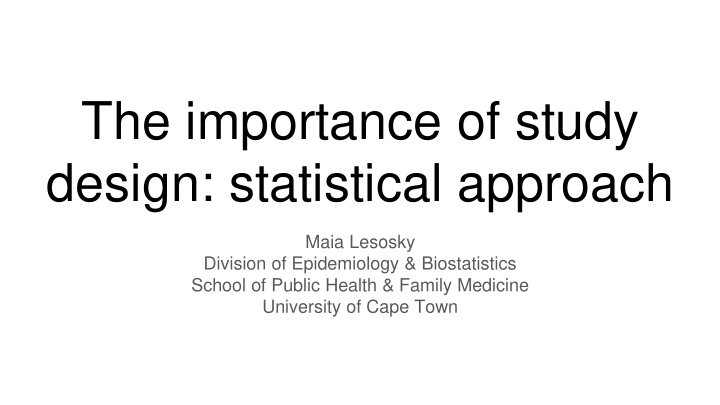



The importance of study design: statistical approach Maia Lesosky Division of Epidemiology & Biostatistics School of Public Health & Family Medicine University of Cape Town
Ethical animal research ● Scientific validity ● Three ‘R’s: Replace, Refine, Reduce ● Replace: New models, mathematical/statistical models (?) - more could be done here ● Refine: minimize harm, use trained personnel, better housing etc – all of these things are improving and improved ● Reduce: the topic of my talk (mainly)
A necessary condition for transferability is sound science
Scientific validity: - Validity is a hard construct to measure. Research may be ‘internally’ valid, but externally invalid. - Internal validity is controllable and mainly a reflection on study design and analytic principles Scientifically unsound research is unethical by definition.
Sound study design begins with the research question ● Pilot studies: “Does this exist/happen/possible?” ● Exploratory studies: “What happens when….?” ● Confirmatory studies: “Is A better then B?” Each of these should have different approaches to design, power, sample size and analysis.
Sound study design A design appropriate for the research question Enough numbers (n) to resolve the hypothesis without ambiguity. Reduction/removal of known sources of bias: - Randomisation - Blinding - Intention-to-treat analysis - Publishing all (not just significant) results - Pre-registration of protocols & analysis plans
The vast majority of studies (even human)… ● Are underpowered ● Do not replicate
● More statistical attention (training, material) is paid to confirmatory studies (both in design and in analysis) then to other types of studies ● Sometimes this results in a mismatch between researcher needs and researcher knowledge ● Plus: study design has moved on..
Modern study design is far more complex than most clinical/pre-clinical researchers have had exposure to. Eg. adaptive and group sequential designs, Bayesian frameworks for analysis
Ethical benefits to adaptive design ● Adaptive dose finding decreases the number of subjects exposed to ineffective or toxic doses and allows a faster transition to safe and effective doses. ● Dropping inferior treatment groups allows subjects to be reassigned to ones that are more successful. ● Adaptive treatment switching, biomarker adaptive strategies, and target population enrichment allow subjects to receive better, more individualized care than by random group assignment. ● Adaptive design allows the required number of animals to be reduced if a significant effect is detected early or potentially painful treatments to be dropped if no effect is seen. Int. J. Mol. Sci. 2015, 16, 24048-24058; doi:10.3390/ijms161024048
Unrealistic choice of effect sizes ● “ For animal studies, effects of realistic treatment doses might be small, and therefore appropriately powered studies will have to be large. To increase the generalisability of findings, investigators should plan for heterogeneity in the circumstances of testing. For these large studies to be feasible, consideration should be given to the development of multicentre animal studies.” ● Creating largely homogeneous experiments aids reproducibility and boosts statistical power, but has a cost of generalizability: the few drugs that have translated successfully from animals are effective across a broad range of circumstances (see, for example, E. S. Sena et al . J. Cereb. Blood Flow Metab. 30 , 1905 – 1913; 2010).
Just …issues... ● This is the largest and most comprehensive survey of this kind carried out to date. We provide evidence that many peer- reviewed, animal research publications fail to report important information regarding experimental and statistical methods. ○ Problems with the transparency and robustness of the statistical analysis in 60% ○ Randomisation reported in only 12% ○ 40% used a less efficient study design then was possible
Bias is endemic in animal studies Risk of Bias in Reports of In Vivo Research: A Focus for Improvement Malcolm R. Macleod Aaron Lawson McLean Aikaterini Kyriakopoulou Stylianos Serghiou Arno de Wilde Nicki Sherratt Theo Hirst Rachel Hemblade Zsanett Bahor Cristina Nunes-Fonseca Aparna Potluru Andrew Thomson Julija Baginskitae Kieren Egan Hanna Vesterinen Gillian L. Currie Leonid Churilov David W. Howells Emily S. Sena
Bias reduction ● Humans are biased ● Our own bias is usually invisible to us ● This has been empirically demonstrated over and over ● Bias should be reduced where possible ● Human bias is best reduced by randomisation and blinding ● Typically, when studies are well blinded and concealed and randomised the estimated effect is lower than that of an unblinded equivalent (because our bias is invisible to ourselves) ● Studies should be registered and all results published
● Non-randomised trials had larger effect sizes. ● “Unduly biased animal studies should not be allowed to constitute part of the rationale for human trials.” ● Most animal studies were biased (only 29% reported any randomisation / concealment)
Insufficient training ● The way that many laboratory studies are reported suggests that scientists are unaware that their methodological approach is without rigour. ● Many laboratory scientists have insufficient training in statistical methods and study design. ● This issue might be a more important deficiency than is poor training in clinical researchers, especially for laboratory investigation done by one scientist in an isolated laboratory — by contrast, many people would examine a clinical study protocol and report.
Ethics committees ● Request (require?) better scientific practice ○ Protocol pre-registration ○ Publication of all results ○ Randomisation, blinding, outcome concealment ● Leverage role to motivate for better training opportunities for researchers ○ Statistical methods ○ Study design
Recommend
More recommend